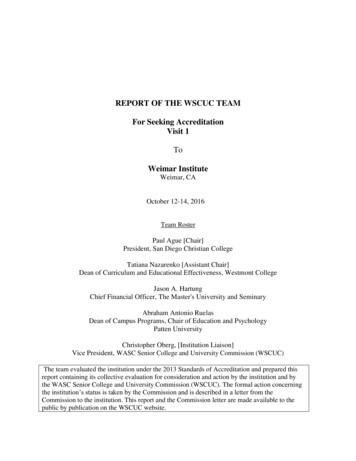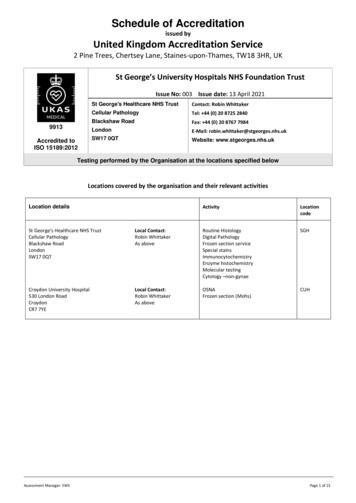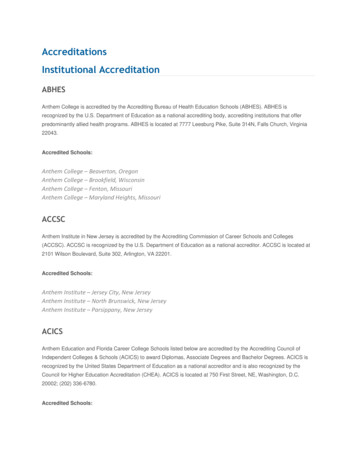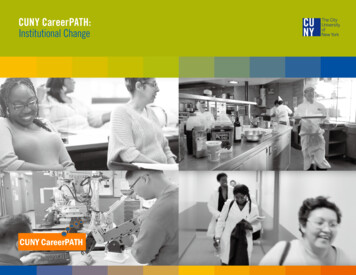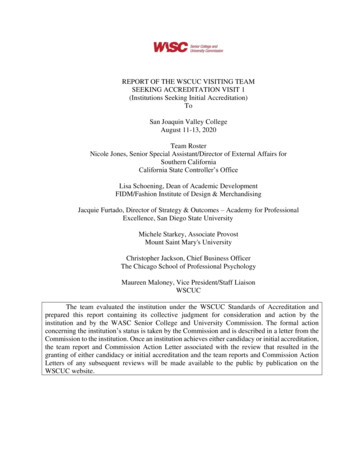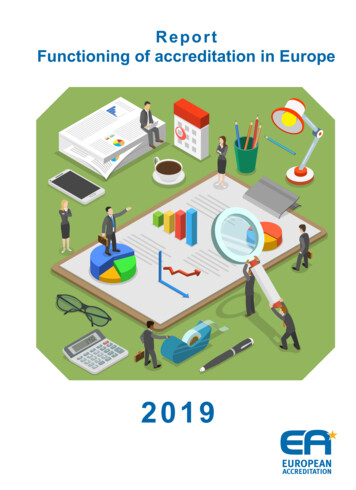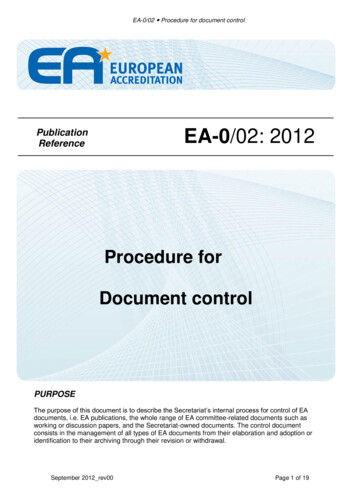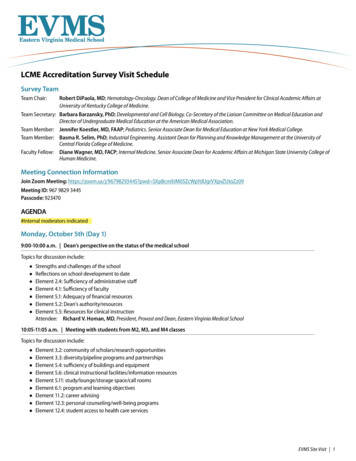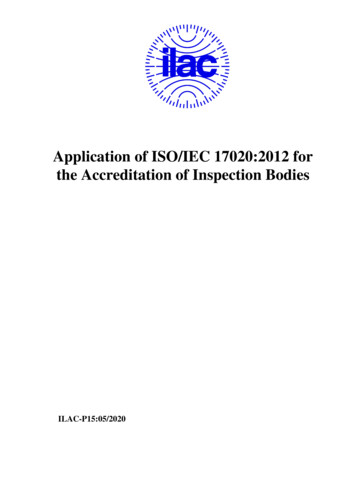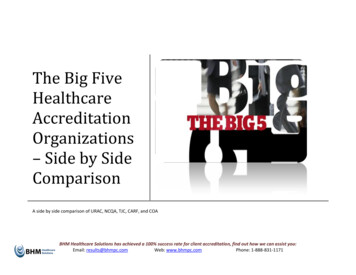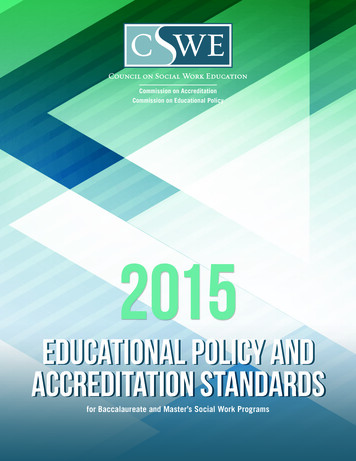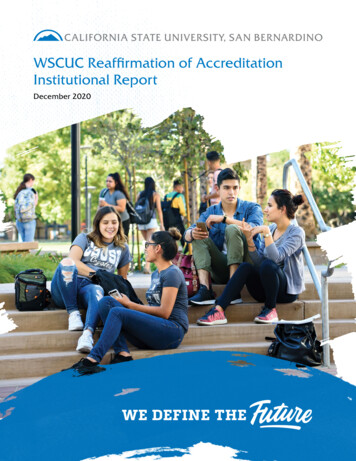
Transcription
WSCUC Reaffirmation of AccreditationInstitutional ReportDecember 2020
Table of ContentsComponent 1. Introduction to the Institutional Report: Institutional Context; Responseto Previous Commission Actions (CFR 1.1, 1.2, 1.4, 2.2a, 2.10, 3.1, 3.5) . . . . . . . . . . . . . . . . . . . . . . . . . . 3Component 2. Compliance with Standards: Review under the WSCUC Standards andCompliance with Federal Requirements; Inventory of Educational Effectiveness Indicators. . . . 11Component 3. Degree Programs: Meaning, Quality, and Integrity of Degrees (CFR 1.1,1.3, 2.2, 2.2a, 2.2b, 2.3, 2.4, 2.8, 2.9, 3.2, 4.4) . . . . . . . . . . . . . . . . . . . . . . . . . . . . . . . . . . . . . . . . . . . . . . . . . 14Component 4. Educational Quality: Student Learning, Core Competencies, andStandards of Performance at Graduation. . . . . . . . . . . . . . . . . . . . . . . . . . . . . . . . . . . . . . . . . . . . . . . . . . . 24Component 5. Student Success Student Learning, Retention, and Graduation (CFR 1.2,2.7, 2.10, 2.11, 2.12, 2.13) . . . . . . . . . . . . . . . . . . . . . . . . . . . . . . . . . . . . . . . . . . . . . . . . . . . . . . . . . . . . . . . . . . . . 32Component 6. Quality Assurance and Improvement: Program Review; Assessment;Use of Data and Evidence (CFR 1.2, 1.4, 1.7, 2.2, 2.3, 2.4, 2.7, 2.10, 4.1, 4.2, 4.3, 4.6). . . . . . . . . . . . . . 41Component 7. Sustainability: Financial Viability; Preparing for the Changing HigherEducation Environment (CFR 1.4, 1.7, 2.10, 2.13, 2.14, 3.3, 3.4, 3.5, 3.6, 3.7, 3.10, 4.2, 4.4). . . . . . . . . 46Component 8. Institution-Specific Theme Quarter-to-Semester Conversion. . . . . . . . . . . . . . . . . . 53Component 9. Conclusion: Reflection and Plans for Improvement. . . . . . . . . . . . . . . . . . . . . . . . . . 61Glossary of Acronyms. . . . . . . . . . . . . . . . . . . . . . . . . . . . . . . . . . . . . . . . . . . . . . . . . . . . . . . . . . . . . . . . . 64Links to Appendices. . . . . . . . . . . . . . . . . . . . . . . . . . . . . . . . . . . . . . . . . . . . . . . . . . . . . . . . . . . . . . . . . . 66WSCUC Reaffirmation of Accreditation Institutional Report 2
Component 1. Introduction to the Institutional Report:Institutional Context; Response to Previous CommissionActions (CFR 1.1, 1.2, 1.4, 2.2a, 2.10, 3.1, 3.5)I. Institutional ContextCalifornia State University, San Bernardino (CSUSB) traces its beginnings to the early 1960s, when the CaliforniaState College system’s Board of Trustees selected a 430-acre site at the foothills of the San Bernardino mountainsto build California State College at San Bernardino. The original three-building campus welcomed its first 293students in 1965 and celebrated its inaugural graduating class in 1967. The campus added a five-story library in1970, and the first dormitories along with the Commons Building in 1972. In 1984, the San Bernardino Campusearned university status and became California State University, San Bernardino.Also in the 1980s, the state legislature allocated funds to establish the Coachella Valley Center (CVC), later tobecome CSUSB’s Palm Desert Campus (PDC). The first class of upper-division students was admitted in 1986.PDC remained primarily a two-year upper-division undergraduate campus, albeit with several graduate andcredential programs, until fall 2013 when PDC welcomed its first freshman class as its first freshman class,becoming the Coachella Valley’s only four-year public university.As described in the sections below, CSUSB has continued to grow the size and diversity of its community, rangeof its programs, and capacity of its facilities.Campus Community (CFR 1.4, 2.2a, 3.1)As of fall 2020, CSUSB has more than 19,404 students: 17,123 undergraduates and 2,281 graduate students. Atotal of 3,618 (19%) students are enrolled in at least one unit at PDC. Numbers of both incoming and graduatingstudents have also increased. In fall 2020, 5,157 undergraduates were newly matriculated (2,286 first-timefreshmen and 2,871 transfer students), and the institution had a record 735 new graduate students. In 20192020, 5,697 students earned their CSUSB degree, 5,336 at the San Bernardino campus and 361 at PDC, the largestnumber of graduates in an academic year for each campus. And as a result of the institution’s efforts on the CSUsystem Graduation Initiative 2025 (GI 2025), CSUSB’s graduation rates continue to climb (see component 5).WSCUC Reaffirmation of Accreditation Institutional Report 3
CSUSB’s student body is diverse, reflecting the dynamic demographics of the region. As of fall 2020, thestudent body is 66% Hispanic, 12% White, 6% non-resident foreign students, 5% African American, 5% Asian, 4%Unknown, 2% two or more races, and .4% Native American/Alaskan Native or Native Hawaiian/Pacific Islander.Of the 19,404 students, 12,167 (63%) are female and 7,237 (37%) are male. The average ages of undergraduateand graduate students are 22 and 32, respectively. Eighty-one percent of the student body are first-generationcollege students, and 58% of undergraduates are low-income (Pell Grant recipients) (CFR 1.4, 2.2a, 3.1).A federally-designated Hispanic-Serving Institution (HSI), Minority-Serving Institution (MSI), and member of theHispanic Association for Colleges and Universities (HACU), CSUSB has the second highest Hispanic enrollmentsof all public universities in California. Indeed, diversity, both in recruitment and retention of students of color,is a key priority of the institution, with a recent focus on Black and Native American students. In 2017, PresidentTomás D. Morales established two task forces on recruiting and supporting the success of African Americanand Native American students, respectively. In response to the task forces’ recommendations as well as toongoing exigencies in the community, CSUSB runs multiple programs supporting African American and NativeAmerican middle and high school students and their families in college preparation and admissions processes.These programs include the Black Student Leadership Symposium, Black and Brown Conference, and CoyotesRising Native Summer Bridge program, First People’s Center open house, and virtual recruitment events incollaboration with tribal educational leaders. In addition, CSUSB participates in Super Sunday partnerships withlocal churches, encouraging youth to attend college and providing services in admissions and financial aid. Asa testament to the institution’s strong ties to local Native American communities, in 2018, CSUSB was awardeda 960,000 philanthropic grant from the Santos Manuel Band of Mission Indians, one of its key communityeducational partners, to increase Native American student college enrollment at CSUSB and across the state ofCalifornia. CSUSB has also established a Diversity, Equity, and Inclusion (DEI) Board with a focus on recruitment,retention, and graduation of historically underrepresented groups and students of color (see component 7).As with the student body, faculty and staff ranks have also grown over the last five years. In fall 2015, CSUSB had463 tenure-line and 737 lecturer faculty. As of fall 2020, the faculty is comprised of 522 tenure-line members (281professors, 92 associate professors, and 149 assistant professors) and 457 lecturers (68 full-time and 389 parttime adjunct). The number of tenure-track faculty hired since 2015 is 190, resulting in 50 net new tenure-trackpositions. In 2015, CSUSB had 972 staff members; as of fall 2020, that number has grown to 1,116. As describedfurther in components 2 and 3, the university has made significant progress in increasing tenure-line facultydensity.Also central to the CSUSB community are the alumni, who now number more than 110,000. The Office of AlumniRelations reports a 738% increase since 2015 in alumni engagement with the institution. In addition, new alumnichapters have been launched, including the Pan African Alumni chapter and the first Undocumented Alumnichapter in the CSU.Colleges and ProgramsCSUSB’s five academic colleges—Arts and Letters, Business and Public Administration, Education, NaturalSciences, and Social and Behavioral Sciences—offer more than 100 baccalaureate and master’s degreeprograms; many minors, credentials, and certificates; and a doctoral program in Educational Leadership. Recentadditions to the degree offerings include an MS in National Cyber Security Studies, MFA in Studio Art, MS inEntrepreneurship and Innovation, BS in Computer Engineering, and BS in Intelligence and Crime Analysis.The institution’s colleges and programs have an ongoing record of academic excellence, curricular rigor, andinnovative pedagogy. Interdisciplinary programs in Entrepreneurship, for example, combine the teaching ofentrepreneurial concepts with experiential learning; and the new School of Entrepreneurship, a first of its kind inCalifornia, is set to open in the Jack H. Brown College of Business and Public Administration. CSUSB’s successfulcybersecurity master’s program is a national leader, earning a Center of Academic Excellence designationWSCUC Reaffirmation of Accreditation Institutional Report 4
from the National Security Agency and Department of Homeland Security. Arts and Letters programs providestudents with transformative experiences, such as opportunities for the CSUSB orchestra to perform in 2019 atKorea’s Seoul Arts Center; for English majors to produce the long-running literary magazine Pacific Review; andfor Communication Studies and Graphic Design students to earn multiple awards in the American AdvertisingFederation competition.In Natural Sciences, undergraduates pursuing STEM degrees will travel to New Zealand to research newmaterials for various technologies, an experience made possible through a 300,000 grant from the NationalScience Foundation. In Social and Behavioral Sciences, history majors produce the journal History in theMaking and received first prize from the Phi Alpha Theta National History Honor Society in the graduate printjournal competition. In addition, the Model United Nations (UN) program allows students to compete in theNational UN conferences in New York City and various international locales. The CSUSB team has won theUN conference’s Outstanding Delegation Award for multiple years. In Education, students are succeeding inachieving professional milestones. Those in the educational administration programs had a 100% pass rate onthe California Administrator Performance Assessment (CalAPA) in 2019-2020. In addition, single-subject andmultiple-subject teaching credential candidates have secured teaching positions during the COVID-19 pandemicand supported veteran teachers at their respective school sites with technological expertise gained in theirCSUSB credential programs.CSUSB students also benefit from resources provided by the John M. Pfau Library, including the Virtual LibraryMedia Center, which provides comprehensive assistance on digital media projects. In addition, the LibraryAmbassador Program supports students in conducting research through the guidance of peers. (See alsoResponse to COVID-19 for multiple types of support that the library has provided for students and faculty duringthe pandemic.)These are just a few examples of academic programs making a positive impact on students. Also of note isthe fact that every CSUSB degree program eligible for national accreditation has received it (see component4). In addition, a number of programs have earned high national rankings, including the Master’s in BusinessAdministration, Master’s in Social Work, Bachelor’s in Criminal Justice, Master’s in Public Health, Master of FineArts, Master’s in Rehabilitation Counseling, and Master’s in Industrial and Organizational Psychology. CSUSBis also listed among the best colleges and universities in the western United States by The Princeton Review,Forbes and U.S. News and World Report. In addition, CSUSB in 2019 was ranked sixth out of 1,400 post-secondaryinstitutions nationwide in CollegeNet’s Social Mobility Index, which evaluates how effectively an institutionenrolls students from low-income backgrounds and graduates them into promising careers.Co-curricular and student support and programs also enrich students’ experiences at CSUSB, including academicadvising, supplemental instruction, services for students with disabilities, honors programming, internships,career preparation, affinity centers, community engagement, and study abroad. These are described further incomponents 3 and 5.Centers, Community Engagement, and PartnershipsThe university contains more than a dozen active research and service centers, including the Watson andAssociates Literacy Center, William and Barbara Leonard Transportation Center, Inland Empire EntrepreneurshipCenter, Center for the Study of Hate and Extremism, Palm Springs Center for a Sustainable Environment, andother centers focused on water resources, economics education, global economics, Islamic and Middle Easternstudies, child development, indigenous peoples, health disparities, criminal justice, learning, public opinion,and prison education, among other areas of study and community engagement. Since 1996, CSUSB has alsobeen home to the Robert and Frances Fullerton Museum of Art (RAFFMA), which received accreditation from theAmerican Alliance of Museums in 2008. The museum, which receives 10,000 visitors annually, has a permanentcollection of ceramics, contemporary art, and Egyptian antiquities, as well as a number of visiting exhibitions.WSCUC Reaffirmation of Accreditation Institutional Report 5
CSUSB is highly active in the community, as seen in the Office of Community Engagement’s multiple servicedays, support for service learning and community-based research programs, which are described in component3. Indeed, CSUSB has earned the prestigious Carnegie Classification for Community Engagement.Among the university’s community partnership programs is Growing Inland Achievement, a network of localeducational, business, and civic leaders who create and support equity-minded programs for college and careerreadiness of students in the region. CSUSB faculty have also brought academic and arts programming to localprisons through the Prison Arts Collective and Center for the Study of Correctional Education. In addition, theDepartment of Art and Design has partnered with the Riverside Art Museum on collaborative activities for theCheech Marin Center for Chicano Art, Culture, and Industry.FacilitiesIn the last five years, CSUSB has undertaken multiple expansions and transformations of its facilities in orderto better support students, faculty, and staff. Working with a reinvigorated Master Plan, in 2016 CSUSB brokeground on a new student housing and dining complex (Coyote Village), both of which opened in fall 2018. At164,000 square feet, Coyote Village is the largest construction project in CSUSB history. It serves as the homeof 407 first-year students, the University Honors Program, and a Faculty in Residence Program. In addition,a 24/7 student study lounge, “The Cave,” opened in 2019. In 2017, the university created the Faculty Centerfor Excellence (FCE), a well-resourced space for faculty work, on the fourth floor of the library. The StaffDevelopment Center (SDC) was also opened in 2017, to provide professional development resources for staff. Thenext major building project was the Center for Global Innovation (CGI), which opened in 2019 as the new homeof the College of Extended and Global Education (CEGE). The university also looks forward to the completionof the Santos Manuel Student Union expansion in fall 2021, as well as the new Performing Arts Center andCollege of Arts and Letters building, scheduled to be finished by fall 2024. See also the flyover video of the SanBernardino Master Plan.For PDC, a master plan was completed in 2016 that envisions a “complete University environment” for theinstitution, with new academic and student support centers, on-campus housing and dining, athletic andrecreational facilities, and sustainability initiatives. Recommendations for expanding the academic programs atPDC were also made in 2019 and are described in component 3.Changes in Administrative StructureAdministrative changes since the last accreditation include the hiring of a new provost and reorganizationof the Division of Academic Affairs. As part of that reorganization, Enrollment Management and Admissionshave moved from Student Affairs to Academic Affairs. Academic Affairs also now has a dedicated Office ofAssessment. In addition, the Center for International Services and Programs (CISP) has shifted from AcademicAffairs to CEGE.The Office of Academic Personnel has become the Office of Faculty Affairs and Development, whose associateprovost oversees faculty retention, promotion, and tenure; faculty recruitment; faculty labor relations andgrievances; academic student employment; and faculty development. The vice provost of academic programsand accreditation liaison officer (ALO) holds the additional position of deputy provost, coordinating AcademicAffairs initiatives. The dean of graduate studies also holds the elevated position of associate provost foracademic research and provides planning and assistance to promote faculty and student research, scholarship,and creative activities that support the educational and service mission of the university.The university now has three co-chief diversity officers. Reporting to the president, the associate provostfor faculty affairs and development, the associate vice president of human resources, and the associate vicepresident for student affairs and dean of students coordinate institution diversity initiatives.WSCUC Reaffirmation of Accreditation Institutional Report 6
II. Major Events Since Last ReviewDuring CSUSB’s last reaccreditation review, an all-institution effort was in progress to create a new strategic planfor the years 2015-2020. The resulting plan, Strategic Plan 2015-2020, included new mission, vision and valuesstatements, along with an implementation plan which has been reviewed on an annual basis. This strategic planhas guided the university’s priorities over these subsequent five years. It has been expanded and extended fortwo years (CSUSB Strategic Plan Extension and Expansion Plan 2020-2022) to enable another thorough reviewand re-visioning exercise after the university moved into the new semester system (see components 2 and 9).The strategic plan is discussed further below, under Responses to Previous Commission Actions.Among other major events since the last review are CSUSB’s capital campaign, 50th anniversary celebration, andupdate of its master plans for both the San Bernardino and the Palm Desert Campuses. Each of these initiativeshas, like the strategic planning process, been organic and inclusive of faculty, staff, student, and communityvoices. CSUSB is also participating in the CSU Chancellor’s GI 2025, whose key goals are to improve studentgraduation and retention rates and to eliminate achievement gaps between student demographic groups.CSUSB’s progress on GI 2025 goals is discussed in component 5.Perhaps the most transformative of CSUSB’s initiatives has been the Quarter to Semester (Q2S) all-institutionconversion process. A five-year project, Q2S has involved extensive transformation of academic programsand support services, as well as strengthening of university assessment practices, as described further incomponents 4 and 8.The most disruptive and unanticipated event has been the COVID-19 pandemic. The university’s response, whichhas required a transition to virtual instruction along with telecommuting by non-essential university employees,has been accomplished with both dispatch and collaborative spirit. Throughout, the university’s goal hasbeen to protect the health of students, faculty, and staff while ensuring the resiliency of its academic mission.The institution is particularly grate
As described in the sections below, CSUSB has continued to grow the size and diversity of its community, range of its programs, and capacity of its facilities. Campus Community (CFR 1.4, 2.2a, 3.1) As of fall 2020,
